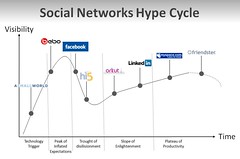Thursday, December 31, 2009
What price does your brand pay for discounting?
The Gap reached an adjusted high of about $55 per share in 2000, but has been bouncing along in the high 20's or low 30's since around 2002. It would be interesting to know when they started their aggressive discounting policy. My guess is that it began when the stock began to fall and competition increased.
Discounting is common in all industries, particularly the software vertical where customers expect a discount and will wait until a quarters end to get the best possible price. I worked at The Mathworks a few years ago and they are the only firm that I know of that refuses to discount and actually gets away with it. Customers now know the discount policy and do not ask for one. The Mathworks has been a very fast growing company in a competitive space so it is interesting that they continue to be able to get away without discounting. I believe they have done a great job of linking price to value and have enhanced their brand in the eyes of their customers. They are a model that others should try to replicate.
Recently, a competitor of ours at Harvard Business Publishing has been offering a 25% discount on their courses through year end. The competitor is a high end, well know brand in the corporate learning space so it was a big surprise that they were doing so. Their policy is a great competitive selling point for us as we can plant the seed of doubt in our prospects minds that their courses must be inferior to ours if they have to run a sale.
Once you start to discount your product or service it is very hard to get full price or even raise prices.Price should equal value but if a customer knows you will eventually cave in and discount than you have lost that relationship and your brand suffers in the end.
Tuesday, December 29, 2009
How do you break through the noise of Twitter?
Yes, I know there are tools that can help you track and find certain topics, but these seem more geared toward the marketer trying to analyze their own data rather than an end user seeking out specific information. The constant flow of tweets makes it difficult to leverage your Twitter network for inbound marketing purposes. I have had some success with inbound marketing when I have offered free white papers or articles, but not everyone has access to the Harvard Business Publishing library like I do.
I would be interested in hearing how others have succeeded or failed in trying to break through the constant noise of tweets to generate tangible business results.
Tuesday, November 24, 2009
Can a B2B product be a luxury brand and marketed as such?
Luxury brands command a price premium and usually justify the higher price by messaging the emotional benefits of owning such a product and implying that access is limited to only an elite few.
The P's are well defined in the marketing of luxury B2C brands but can a B2B brand also take some cues from these products in our own marketing?
Looking at a few of the luxury brand traits, you can see that B2B brands have the potential to market themselves as higher level than other products.
- Pricing power: High
- Emotional pull: High
- Status: High
Thursday, November 5, 2009
See my winning blog post for the innovation contest for October
http://bit.ly/kxRmq
Wednesday, October 21, 2009
Update to Death of a Salesman post
Amazon: The Web giant's cache of consumer-generated reviews lures ever-more shoppers, who increasingly research products before buying
"Amazon's review program reflects a new reality for the way consumers shop in the Digital Age: The Internet has become the world's greatest research tool, and consumers hardly buy anything anymore without first getting the skinny online. Some 70% of Americans say they consult product reviews or consumer ratings before making a purchase, according to an October 2008 survey by Penn, Schoen & Berland Associates, a research and consulting firm. Amazon has played a central role in the change in consumer behavior by being the first successful Web retailer to embrace consumers' views. "What we try to spend our time on is harnessing customer passion," says Russell Dicker, Amazon.com's senior manager of community." bit.ly/25mYeg
FaceBook: They're reaching customers via new tools such as Facebook Connect and pushing the social network toward profitability
"Merrill Squires avoids car salesmen at all costs. So when the 48-year-old marketing executive from Dallas was choosing between a Chevrolet Tahoe and a GMC Yukon Denali recently, he turned to his 600 Facebook friends. Dozens responded, and one old pal—a Denali owner—steered him toward the Tahoe. "I trust his opinion on it, and I would never have thought to pick up the phone and call him," Squires says. bit.ly/2dshZJ
As one commneter posted on the original post, big, complex sales will always need a salesperson, but I bet that the salesperson comes in later in the salescycle after the research has been done.
How can you control what they see?
Thursday, October 15, 2009
Death of Salesman?
There are certainly some products where face to face interaction is critical in the selling process. However, with more people doing research beforehand on social media sites and seeking out opinions/reviews on products, will marketing have to monitor those areas to make sure the correct message and information can be found. This role of gatekeeper seems more suited for marketing than sales to me.
Marketing's key role is communicating with the customer until they are ready to buy. Social media sites provide a great venue for this conversation. I do not think it is too far fetched to think that marketing could become a key player in turning prospects in customers without interaction from sales.
Friday, October 9, 2009
Augment your SEM and SEO programs with SMM and SMO
The interesting thing about SMM and SMO is that it allows you to inexpensively test words to see what resonates with your followers. Maybe these will be the same words that you are using in your SEM/SEO efforts, but you may passibly discover words you had not thought of before and these could turn out to be cheaper than some of the more popular words.
SMO and SMM should be part of your overall marketing strategy and the good thing is that there is not hit to your budget!
Thursday, September 24, 2009
Building the platform for long term success
Now, when you buy something (that thing you used to call 'media'), you're not paying for eyeballs, you're paying for a platform. A platform you can use to build your own audience, one that you can nurture, educate and ultimately convert. You'll take care of this audience differently, measure them differently and have a different sales cycle. This isn't natural, but it works.
I am fortunate to work for a company, Harvard Business Publishing, that has a world class brand and a terrific platform. However, I do not believe that we have taken advantage of this platform to attract people across all of our properties. We have the ability to offer a plethora of content, from blogs by leading experts, books, Harvard Business Review articles, Harvard cases, online leadership development and Executive Education. To move towards Seth's vision, we need to leverage all of these properties to build an audience. Like any company that has multiple product lines, we tend to work in our own silos, worrying only about our audience. However, if we were to look at all of our properties and audiences as one and deliver advice and content that is relevant and timely then we could build a hugely successful platform that would allow us to get to the conversion rates that Seth mentions.
The problem is, how do we get there?
Friday, September 18, 2009
Can social media take the place of marketing automation platforms?
Another important aspect of social media that can't be replicated by a MAP is highlighted by the findings in the recent Nielsen Global Online Consumer Survey as seen in the chart above. The survey found that recommendations from personal acquaintances or opinions posted by consumers online are the most trusted forms of advertising. Ninety percent or consumers surveyed noted that they trust recommendations from people they know, while 70 percent trusted consumer opinions posted online.
“The explosion in Consumer Generated Media over the last couple of years means consumers’ reliance on word of mouth in the decision-making process, either from people they know or online consumers they don’t, has increased significantly,” says Jonathan Carson, President of Online, International, for the Nielsen Company.”
Marketing is all about building trust and being relevant to the consumer. I know I regularly look at recommendations on sites like Best Buy before I purchase any electronics. I do not know these people, but it goes back to James Surowiecki's Wisdom of Crowds theory, "under the right circumstances, groups are remarkably intelligent, and are often smarter than the smartest people in them." Social media has a much greater advantage over a marketing platform because a Tweet to people who follow you is more likely to be taken more seriously than an email from a campaign.
Think of the power of some of the services below and compare them to how you would react to items posted there versus an email in your inbox from a vendor that you may have a passing knowledge of but no real relationship. What do you trust and believe more?
- Digg
- Stumbleupon
- revver
- Gist
- knol (yes, knol)
- Meetup
- Youtube
- Hollr
I've entered this article in Blogging Innovation's October Innovation Contest - To show your support for this article, please follow the link and add a comment.
Wednesday, September 16, 2009
It took how many users for Facebook to become cash flow positive?
 Image via Wikipedia
Image via Wikipedia- They crossed 300 million users worldwide
- They are now cash flow positive (they were EBIDTA positive).
From Techcrunch: The company is likely spending well over a $1 million per month on electricity alone, say experts we’ve spoken with. Bandwidth is likely another $500,000 or more per month on top of that. The company has earmarked $100 million to buy 50,000 servers this year and next. And sources say they’ve been buying one NetApp 3070 storage system per week (me: like to be that sales rep) just to keep up with all this user generated content. At up to $2 million each, that adds up quickly – we’ve heard estimates that they may have spent as much as $30 million this year alone with the company. And the icing on the cake – earmark another $15 million per year in office and datacenter rent payments.
One of the difficulties cited to becoming CF positive was the huge amount of photos that are uploaded and stored on Facebook. However, I do not see the growth in uploads of pictures decreasing any time soon so how do they continue to scale (even with Haystack) and have the corresponding revenues to stay positive? What if utilization rates of users drop off making it harder to attract advertising (already limited). How do they keep adding people and keep up usage? How do they generate more revenue/user? It will be interesting to watch. Any one else have any thoughts?
Thursday, September 10, 2009
Eloqua and social networking
 Image by fredcavazza via Flickr
Image by fredcavazza via Flickr
My company, Harvard Business Publishing, had a full time person working on Eloqua up until about 4 months ago. Since then I have been in charge of it. I have a basic understanding and really had just been using it for email campaigns. Lately, I have been trying to utilize more of the functionality to help drive leads.
One very interesting campaign I just launched involved placing links to Twitter, Facebook and LinkedIn on the landing page and encourage people to use those platforms to pass along information about the article we were giving away.The audience was probably not perfect for this experiment (high level C types), but the potential is very intriguing. Considering that many firms are seeing traffic from these sites explode I hope to take advantage of this trend for our website.
The one outstanding question is does our customer base utilize any of these services. I know a lot of our prospects are on LinkedIn yet I do not know how many are on Twitter. I expect few to be on Facebook, let alone use it for business. All of this goes back to a previous post I made about whether or not every business can use social media sites to driver traffic (Can any site use social media to drive traffic?). I think this will be a good experiment and possibly provide a glimmer of an answer to that question.
You can see the landing page here
Thursday, July 9, 2009
The voodoo that you do to price software
 Image via Wikipedia
Image via Wikipedia
Marketing: Pricing should reside in marketing as part of the marketing mix. Mostly it does, but not without a lot of "marketing" volunteers.
Sales: In their opinion, since they actually develop proposals and talk to users about pricing, they own it and have the most knowledge of it. Marketing? Who needs marketing. Sales will tell us what the price should be, marketing just needs to develop a nice little slick.
Product Development: They want to make sure their "baby" is priced appropriately given all of the hard work and features and functions that are included (even if they are not needed. Hello, Microsoft.)
Accounting/Finance: They are privy to all the costs so they know what we need to generate in revenue to cover the costs and produce an acceptable margin.
CEO: Ultimately it is his/her head on the line if numbers are not met.
Your mother: OK, kidding, but just barely.
So be careful, once the subject of pricing is actually broached, be prepared for a lot of bitter feelings, hurt looks, and fighting over who is right.
Wednesday, July 1, 2009
If you have a blog and nobody comments does it really exist?
 Image by Laughing Squid via Flickr
Image by Laughing Squid via Flickr
It does go to show that for a blog to be successful you need a following. Obvious, I know, but what does this mean for businesses who are being told to blog, blog, blog to drive traffic and generate leads but have very little brand recognition or following?
Blog it and they will come? Not so much.
Wednesday, May 20, 2009
Comments as market research
I have recently been reading a lot of the comments on The Boston Globe's website, in particular, about the proposed tax increases here in Massachusetts. If I were a politician I would be reading the overwhelming critical comments and wonder about my future if I supported the increases. Some articles produce 100's of comments that provide great insight into the issue as well as alternatives to help solve the crisis. These comments may be a politicians nightmare, but they are a market analysts dream.
The current methods of focus groups, surveys and phone interviews are certainly useful, but gathering reliable market intelligence in these ways is time consuming, inconsistent and unreliable. What good is running a survey if you only get 15 responses? It would be so much easier if you could mine comments to see immediate feedback on product concepts, positioning statements or other elements you are trying to test and gather feedback.
Obviously, there are many analytics out there such as Google analytics and others (see a good overview of some tools here). However, these tools appear to only provide tracking data on site visitors, sign ups, etc. I wonder if there is a firm out there that can mine comments and provide an analysis of the content for reliable market intelligence. Anyone know of such a firm?
UPDATE: Just came across a firm called Crimson Hexagon, Crimson Hexagon's VoxTrot listening platform provides companies with actionable insight into consumer opinion of their brand, product, or market. VoxTrot technology can identify opinion from large quantities of text, whether it's an in-house content repository or the vast blogosphere. Pretty cool.
Tuesday, April 7, 2009
Can anyone use social networks to drive traffic?
 Image via CrunchBase
Image via CrunchBaseThat type of trend begs the question: Why aren't' all firms, B2B and B2C, using Facebook or any of the other social media platforms to drive customers to their websites? First, you need to think about whom is your typical customer and ask which social media platform they would frequent for information to help them do their job.
Facebook has seen huge growth in adults lately. The growth in older adults would make you think that Facebook is a great place to interact with your customers. However, do you believe that your target market is frequenting Facebook for work? If the answer is no, then move on but continue to monitor its relevance for you audiences.
A lot has been written about Twitter, a micro blogging site. Twitter also has seen huge growth rates, particularly in the workplace. In fact, in February the largest age group on Twitter was the age group 35-49 (42 percent of the site’s audience). Nielson ratings found that the majority of people visit Twitter.com while at work, with 62 percent of the unique audience accessing the site from work only versus 35 percent that accessed it from home only. Again, this is a pretty amazing trend. However, if you look at the top followed people on Twitter you see that Britney Spears is #3, Shaq is #8 and Whole Foods Market is #24. These facts may lead you to believe that Twitter is not a place that your target market is going for information about your product.
At my work, I am currently discussing setting up a Harvard Business Publishing Group on LinkedIn. We feel that LinkedIn’s business focus lends itself well to interacting with our prospects and partners. In fact, according to the latest January data from comScore, the LinkedIn’s U.S. unique visitors shot up 22 percent to 7.7 million, up from 6.3 million in December. Total minutes spent on the site doubled in January to 96.8 million, from 47.6 million in December. These trends do make us feel comfortable that LinkedIn may be a good place to interact, and help, our customers.
Wednesday, April 1, 2009
Web Marketing Manager opening
Harvard Business Publishing is seeking a highly motivated individual for the role of Web Marketing Manager. This person will be responsible for creating and managing marketing campaigns designed to generate quality leads for our sales team. This position will work closely with our corporate marketing team and sales team to develop a solid strategy for quick response to the resulting leads. The individual will also be responsible for the Corporate Learning website, editing/proofreading content for style, accuracy, grammar, punctuation, spelling, and search engine friendliness. This person will manage the content development and overall design of the website to ensure branding strategies and marketing plans are effectively administered through the site.
The ideal candidate will have a strong background in driving qualified sales leads and will have a track record of demonstrated success in demand generation. The candidate will have experience creating/managing and maintaining a highly engaging and interactive website. The candidate must possess strong leadership skills, outstanding communications skills, and the ability to adapt quickly in a changing environment. Prior experience in a fast paced, high growth emerging business is desired.
Responsibilities:
1. Manage strong web marketing campaigns to drive qualified sales leads and awareness in our target industries. Work cross-functionally with product marketing and sales team to create targeted web-based campaigns including: webinars, Google AdWords, and other lead-generation campaigns.
2. Develop all internal and external communications to support the campaigns including email invitations, online ad/landing page content and newsletter sponsorships.
3. Manage online events including the development of strong messaging and the ability to drive traffic to our website. Define budgets and campaign metrics, monitoring and measuring campaigns to improve results and achieve lead goals.
4. Manage Corporate Learning Website including all content updates, multimedia content, identify and execute new programs based on a target account/target industry strategy.
5. Track and report on all programs and resulting leads. Effectively communicate the results to sales and marketing management for continuous improvement and refinement.
6. Oversee internet and electronic marketing media activities to include: Search Engine Optimizer/Search Engine Marketing, internet advertising, e-mail campaigns, customer data capture, social media, viral campaigns, affiliate marketing, mobile marketing, etc.
7. Develop promotional and informational e-mail list through utilization of our customer and prospect lead database.
Qualifications:
- 5+ years experience in B2B marketing, with demonstrable track-record in demand generation and campaign execution
- Highly motivated, self-starter who thrives under tight deadlines; quick learner with a "roll up the sleeves" approach and attention to detail.
- Experience working closely with field sales team
- Highly proficient in MS Office (Word, Excel and PowerPoint); CRM tools such as Oracle and Webex (or other Web events program) highly desirable
- Experience using Eloqua a plus
- Experience in pay-per-click, online advertising and SEO a plus
- Strong interpersonal skills
- Travel required: 15-20%
- Bachelor's degree in marketing or related field; MBA a plus
Friday, March 20, 2009
Some Advice to Sales
 Image via Wikipedia
Image via Wikipedia
We received some good feedback that can definitely help us refine some of our programs and messaging. However, it also produced some frustrating moments, most particularly with the sales people who consider themselves marketing professionals. I am not sure this attitude happens between any other groups. Would you go up to accounting and give them advice because you do your own taxes or balance the checkbook?
Sales is a great source of information because of their frequent customer interactions that marketing cannot replicate. That said, I know marketing, you know sales, let me do my job and I promise not give you any suggestions on proper cold call techniques.
Friday, March 13, 2009
Is Twitter and FaceBook a vialble source of traffic for all firms?
In my case, it is not obvious given my firms brand (Harvard Business Publishing) and the restrictions surrounding the use of it for marketing purposes. Not only do the restrictions have to be weighed, but would Twitter and FaceBook have the same effect on driving traffic to our site?
Given the impact of Twitter and FaceBook, we will certainly look into having a presence and it will be interesting to see, brand restrictions aside, what the outcome will be if we do use these outlets.
Friday, February 20, 2009
Workflow marketing
Workflow marketing is introducing your product when it is needed in a prospects daily routine. Interacting at the right moment is where social networking, blogs, ratings, wikis, audio, groups, etc. are so powerful because they are becoming ingrained in our every day routine and firms can leverage these tools to interact with prospects to start a conversation.
Workflow marketing is the opposite of flooding people with information in the hopes that they will remember you when the time is right. The key is to be there when your customer is seeking what they need as they will be more open to a dialog. Obviously, this is similar to behavioral marketing and targeting but I think it goes beyond those tools because it is less intrusive, less obvious and more welcoming to the prospect.
Less with less vs. more with more
 Image via Wikipedia
Image via Wikipedia
Web 2.0 tools now allow you to get even closer to your customer at minimal cost. Set your blog up to let your customers know what you are up to and also shed some light into the struggles that your own organization is experiencing. Set up FaceBook pages and start/join groups on Linkedin. Start to interact with peers to see how and what they are doing with less. The key is to become more open, more public, not secretive or go into bunker mentality and "ride it out." Everyone is in the same boat and looking for help and advice. The power of the network allows you to turn less with less into more with more.
Tuesday, February 17, 2009
Product Development: Incremental changes vs. blowing it up
The question arises: do we build for the next generation of users now( blow it up) or perform incremental changes and arrive "there" in 3 years?
I personally favor blowing it up and building something completely new. The market is ripe for change with no real leader in the space. We have the opportunity to be very forward looking, something our customers expect from us. An incremental change will be warmly greeted by our customers, but not in an overwhelming, tell your friends, we have to have this sort of way. The technology is there, we just need use it!


![Reblog this post [with Zemanta]](http://img.zemanta.com/reblog_e.png?x-id=dd7c15be-a3ee-4376-a5f8-0aafb99e534c)

![Reblog this post [with Zemanta]](http://img.zemanta.com/reblog_e.png?x-id=eca99d29-51be-4fc4-9dab-2d816674bdb8)
![Reblog this post [with Zemanta]](http://img.zemanta.com/reblog_e.png?x-id=01203fb7-9cef-4608-943a-1484303dea82)

![Reblog this post [with Zemanta]](http://img.zemanta.com/reblog_e.png?x-id=2066f0b3-95ed-432b-a288-a3401e8a8b48)

![Reblog this post [with Zemanta]](http://img.zemanta.com/reblog_e.png?x-id=f1721119-6fd9-4bee-8f7a-2c642c098a9d)

![Reblog this post [with Zemanta]](http://img.zemanta.com/reblog_e.png?x-id=444ee884-76d7-4809-a651-745c44ccb732)

![Reblog this post [with Zemanta]](http://img.zemanta.com/reblog_e.png?x-id=51476e58-1b3c-4fe0-812d-98a1e5970218)
![Reblog this post [with Zemanta]](http://img.zemanta.com/reblog_e.png?x-id=32baa0bf-07ab-44d5-a6a5-f7b96e5fa60e)
![Reblog this post [with Zemanta]](http://img.zemanta.com/reblog_e.png?x-id=dfc650a5-0729-48c7-9a23-b3ef3a39ced8)
![Reblog this post [with Zemanta]](http://img.zemanta.com/reblog_e.png?x-id=ccda1a34-a307-42f3-9927-1408e03ac21f)
![Reblog this post [with Zemanta]](http://img.zemanta.com/reblog_e.png?x-id=36160e0f-417a-4e5f-81cc-afccbe020048)
![Reblog this post [with Zemanta]](http://img.zemanta.com/reblog_e.png?x-id=05e74d1d-bec5-4052-b761-afdf5583e563)
![Reblog this post [with Zemanta]](http://img.zemanta.com/reblog_e.png?x-id=2318e61c-6235-40d8-8347-ff12d4d3ca95)
![Reblog this post [with Zemanta]](http://img.zemanta.com/reblog_e.png?x-id=82e62677-cf06-40d6-82fc-42943907e206)
![Reblog this post [with Zemanta]](http://img.zemanta.com/reblog_e.png?x-id=98a3aee4-0df9-4963-af5a-f29aaa496746)
![Reblog this post [with Zemanta]](http://img.zemanta.com/reblog_e.png?x-id=7d1d052f-7835-47e6-8d4b-28a4e18a1739)
![Reblog this post [with Zemanta]](http://img.zemanta.com/reblog_e.png?x-id=f8f2bdae-337d-4de2-9f3e-0d97466cef2c)